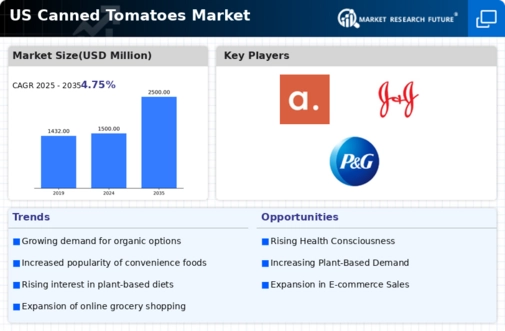Increased Home Cooking Trends
The trend of home cooking has gained momentum, significantly impacting the canned tomatoes market. As more consumers opt to prepare meals at home, the demand for versatile ingredients like canned tomatoes is likely to increase. Canned tomatoes serve as a staple in various cuisines, making them a popular choice for home cooks. Recent statistics suggest that the home cooking segment has expanded by approximately 20% in the last year, which correlates with a rise in canned tomato sales. The canned tomatoes market is thus benefiting from this shift, as consumers seek convenient and time-saving options for meal preparation. This trend may encourage brands to enhance their marketing strategies, emphasizing the ease of use and culinary versatility of canned tomatoes.
Growth of E-commerce Platforms
The rise of e-commerce platforms is transforming the way consumers purchase food products, including canned tomatoes. With the convenience of online shopping, consumers are increasingly turning to digital platforms for their grocery needs. This shift is likely to bolster the canned tomatoes market, as online sales channels provide greater accessibility and variety. Recent data indicates that online grocery sales have surged by 30% in the past year, suggesting a significant opportunity for the canned tomatoes market to expand its reach. Retailers are now focusing on enhancing their online presence and optimizing supply chains to meet the growing demand. This trend may lead to increased competition among brands, ultimately benefiting consumers through better pricing and product availability.
Innovations in Packaging Technology
Innovations in packaging technology are playing a crucial role in the canned tomatoes market. Advances in packaging materials and designs not only enhance product shelf life but also improve consumer convenience. For instance, the introduction of easy-open cans and eco-friendly packaging options is likely to attract environmentally conscious consumers. The canned tomatoes market is witnessing a shift towards sustainable packaging solutions, which may appeal to a broader audience. Recent studies suggest that approximately 40% of consumers prefer products with sustainable packaging, indicating a potential growth area for manufacturers. This focus on innovation may drive competition and encourage brands to invest in research and development to create packaging that meets consumer expectations.
Health Consciousness Among Consumers
The increasing awareness of health and nutrition among consumers appears to be a driving force in the canned tomatoes market. As individuals seek healthier food options, the demand for canned tomatoes, which are rich in vitamins and antioxidants, is likely to rise. According to recent data, the market for canned tomatoes is projected to grow at a CAGR of 4.5% over the next five years. This trend indicates that consumers are gravitating towards products that offer both convenience and health benefits. The canned tomatoes market is thus witnessing a shift towards products that are perceived as healthier alternatives, including low-sodium and organic varieties. This heightened focus on health may lead manufacturers to innovate and diversify their product lines to cater to this growing segment.
Rising Popularity of Plant-Based Diets
The increasing popularity of plant-based diets is influencing the canned tomatoes market. As more consumers adopt vegetarian and vegan lifestyles, the demand for plant-based ingredients, including canned tomatoes, is likely to rise. Canned tomatoes are often used as a base for various plant-based dishes, making them a staple in many households. Recent market analysis indicates that the plant-based food sector has grown by 25% in the last year, which correlates with an uptick in canned tomato sales. The canned tomatoes market is thus positioned to benefit from this trend, as manufacturers may focus on promoting their products as essential components of healthy, plant-based meals. This shift could lead to increased product innovation and marketing efforts aimed at health-conscious consumers.














Leave a Comment